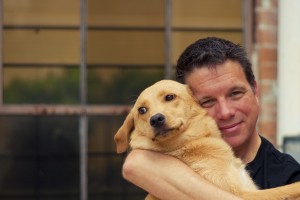Michael Baugh CPDT-KSA, CDBC
It’s one of the most uncomfortable things for us trainers to say to a client. I am always looking for the kindest and most tactful way to say it. “I don’t think your dog really enjoys being patted on the head like that.” It’s tough because the thing is, we humans love to pat and pet and paw on our dogs.
Ethologist and Author Patricia McConnell PhD was one of the first to shine the light on this basic disconnect between humans and dogs. We humans are primates. Our social interactions are played out primarily with our arms and hands. Dogs are canines and they are notably lacking arms and hands. Their social interactions are played out with their whole bodies, but primarily with their mouths. So, it’s no surprise then to find new puppy owners bloodied on their limbs and digits baffled over why their young bundles of teeth keep biting them. It’s also no surprise to see a dog duck away when their person reaches out to pat their head.
 Here’s the rub (literally and figuratively). Even when we know better, we humans keep on keeping on. We don’t get it, even when we get it. Case in point: that picture of me and Stella over there. My face says, I love this dog. Her face says, I don’t care just get me out of here. I knew better but I just couldn’t stop myself. Facebook and Google are littered with videos and pictures like this one, and worse. People hugging dogs who clearly are uncomfortable. Children draped over dogs who are at best tolerating the interaction. We can’t help ourselves. Almost daily we’re highlighting the difference between our species, photographing it, and publishing it for the world to see.
Here’s the rub (literally and figuratively). Even when we know better, we humans keep on keeping on. We don’t get it, even when we get it. Case in point: that picture of me and Stella over there. My face says, I love this dog. Her face says, I don’t care just get me out of here. I knew better but I just couldn’t stop myself. Facebook and Google are littered with videos and pictures like this one, and worse. People hugging dogs who clearly are uncomfortable. Children draped over dogs who are at best tolerating the interaction. We can’t help ourselves. Almost daily we’re highlighting the difference between our species, photographing it, and publishing it for the world to see.
Sometimes I chuckle at myself when I forget and reach for Stella’s head for a nice pat. She, of course, ducks away and I apologize. The laugh is on me. I knew better and couldn’t help myself. Dogs tend to not like hands reaching for them; especially hands belonging to someone they don’t know too well. Some dogs are more sensitive than others (Stella knows me well and still doesn’t care for that kind of greeting). We forget because quite often we greet each other, including strangers, with an extended hand. We call it shaking hands. If we know each other even a little bit better, or if we’re in Europe, we might hug. Hugs to dogs are very alien and offensive. Dogs who drape their heads over another dog’s withers (shoulder area) often get in fights. So do dogs who full-on mount another dog (sort of like hugging).
People who reach for the wrong dog get bitten too. Sometimes the results are serious. Children, unfortunately get bitten most frequently. They’re the ones most likely to hug or even try to ride a dog. It pains me to know some parents don’t know better and actually encourage this. They grab the camera and log on to Facebook. I cringe. At least one dog related fatality this year involved a baby pulling himself up on a dog. Those cases are rare and extreme. It’s easy to blame the dog or the parents. The truth though is that we all need to learn better ways to interact with dogs; we trainers especially need to take the lead on this – teach – learn – teach again. No one who loves their child and loves their dog wants things to go badly. But it happens.
This doesn’t mean dogs don’t like to be touched. Most do. When I’m thinking correctly, I let dogs approach me first. If the dog appears fearful, I’ll turn sideways to the dog, and I might bend at the knees to get down to his level. I don’t reach into the dog’s space or make direct eye contact, the way you might do when you’re greeting a person at a business meeting. If the dog approaches, I pet him on the chest or on the cheek by his ears. Watch to see how he reacts. If he backs away, I stop. Of course, the overwhelming majority of dogs will love this. Many will be exuberant and jump for joy (that’s another issue altogether). Children are always supervised. In Stella’s case, because she is particularly sensitive, interactions with kids are structured and brief.
Trainer educator Jean Donaldson got it right in The Culture Clash. We want our dogs to be like dogs the in the movies. She calls them Disney Dogs. They are cute and always nice, with human sensibilities and manners. That, of course, is a myth. Dogs have their own ways, their own sensibilities, and they are nonetheless still cute and nice. I think they are more so. Nearly perfect in fact. I should remember that when I see a dear client looming over her dog and reaching out. “Your dog is wonderful, and so are you. Let me show you how he likes to greet people. He’s so cute.
“Wait, I’ll get the camera.”


